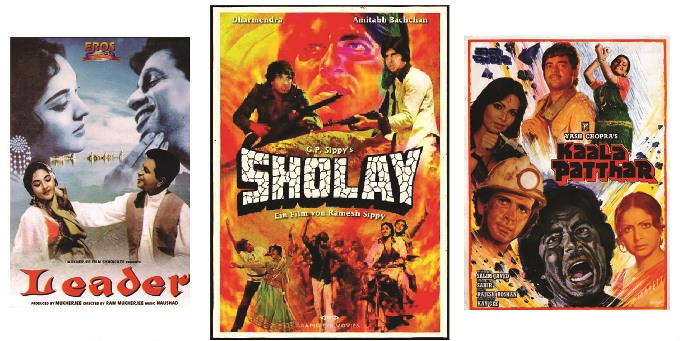The Guardians of India’s Cinematic Heritage
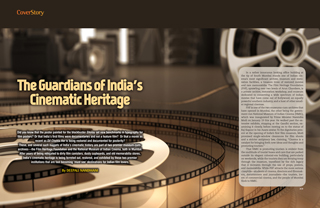
Did you know that the poster painted for the blockbuster Sholay set new benchmarks in typography for film posters? Or that India’s first films were documentaries and not a feature film? Or that a movie as recent as Dil Chahta Hai is being restored and documented for posterity? These, and several such nuggets of India’s cinematic history are part of two premier museum-cumarchives— the Film Heritage Foundation and the National Museum of Indian Cinema, both in Mumbai. After years of being relegated to dirty film canisters, dusty cupboards, and old memorabilia stores, India’s cinematic heritage is being ferreted out, restored, and exhibited by these two premier institutions that are fast becoming ‘must see’ destinations for Indian film lovers.
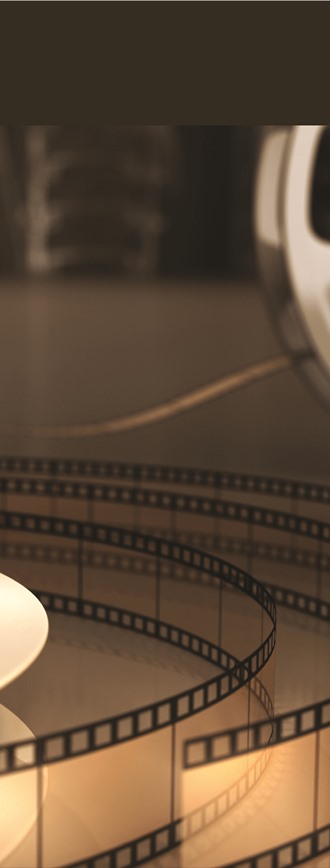
In a rather innocuous looking office building at the tip of South Mumbai stands one of Indian cinema’s most significant archive, museum and restoration facilities, a treasure trove of restored movies and rare memorabilia. The Film Heritage Foundation (FHF), sprawling over two levels of Arun Chambers, is a private archive, restoration workshop, and museum dedicated to conserving a wide spectrum of Indian movies that have come out of Bollywood, an equally powerful southern industry, and a host of other smaller regional cinemas.
FHF is one of the two museums-cum-archives that have opened in Mumbai, the other being the government- run National Museum of Indian Cinema (NMIC), which was inaugurated by Prime Minister Narendra Modi on January 19 this year. He walked past the extensive exhibits, stopping at the Gandhi section, examining it closely, before moving on to the statue of Raj Kapoor in his Awara avatar. To the dignitaries present at the opening of India’s first film museum, Modi promised single-window clearances for film shoots and a stricter antipiracy law, claiming, “Cinema is a catalyst for bringing forth new ideas and thoughts and promoting tourism.”
That NMIC is promoting tourism is evident from the multitude of tourist buses and cars that are parked outside its elegant colonial-era building, particularly on weekends, while the tourists they are ferrying troop through the museum, transfixed by the rich legacy that it recreates through the use of props, posters, and memorabilia. While FHF attracts the more serious cinephile—students of cinema, directors and filmmakers, documenters and journalists—the tourists, lovers of commercial cinema, and the people of Mumbai flock to NMIC.
If film director Gulzar calls FHF “the most significant archive and museum that looks at the evolution of cinema from all perspectives—the art of filmmaking, props, distribution, camera, posters, publicity material, tickets and other memorabilia, which are now part of the archive,” filmmaker and actor Farhan Akhtar believes NMIC is a popular museum focusing on the fun side of cinema. “While they do have some interesting memorabilia, what really works are the fun statues, the interesting little details that they have included, the costumes on display. It is an interesting journey through cinema’s long and complex journey in India.”
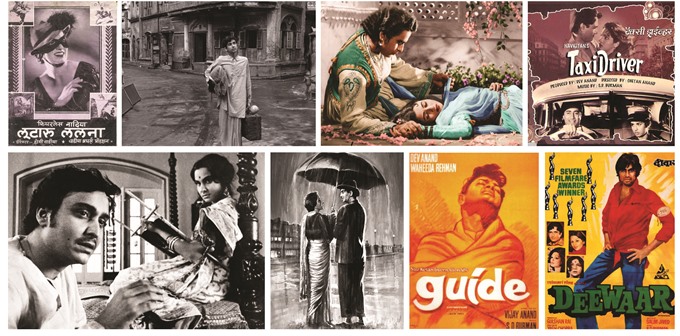
Posters of some iconic Indian films at the Film Heritage Foundation (FHF).
Preserving memories and old cinema
Film Heritage Foundation (FHF) is the passion child of Shivendra Singh Dungarpur, an award-winning filmmaker, archivist, and restorer. At FHF, India’s vibrant cinema history comes alive in the hands of talented restorers and archivists—working in a bone-chilling cold room, looking at old film reels under a microscope or painstakingly searching for scratches and bad patches that need restoration. In another section, archivists document and archive all the various items dating as far back as 1930s and 40s. Stored in climate-controlled display cupboards or vaults, stacked on shelves or hung on the bare white walls are vintage posters, old cinema tickets, publicity material used for movies, song books (Indians used to collect printed books with the lyrics of their favorite songs), props used in movie making, costumes, jewelry, antique cameras, and the personal and professional possessions of a few actors and filmmakers.
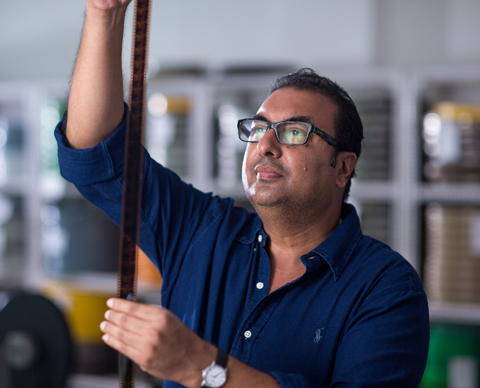
(Right) Shivendra Singh Dungarpur, founder of the Film Heritage Foundation.
“We are dedicated to the development of interdisciplinary programs that help create awareness about the language of cinema. Besides restoring movies, we host restoration workshops to promote the culture of preserving cinema heritage,” Dungarpur says. “We have hosted workshops not just in India, but also across Sri Lanka, Nepal, Bangladesh, Bhutan, Myanmar, and Malaysia.” FHF also prints significant books on cinema, among them Yesterday’s Films for Tomorrow with P. K. Nair’s beautifully penned essays.
Restoring and exhibiting cinematic heritage
Although India makes over 1,500 films a year, “we are an oral culture; our stories, for generations, have been passed down to the next through oral retelling. We aren’t a culture that believes in documenting and preserving,” says filmmaker and poet Gulzar, who is known as a collector of film heritage. “We need to preserve whatever is left, which is where museums and archives such as FHF and NMIC play such an important role.” Much of the valuable material has been lost over years, having made its way to flea markets and bazaars such as the once vibrant Chor Bazaar in Mumbai, where collectors have bought posters and even cinema reels at rates as low as $30 to $50.
“To offer you a perspective, India made 1,700 silent films, of which only five or six survive,” contends Dungarpur. The 55-year-old National Film Archive of India (NFAI), another government-run institute, has about 8,000 titles in its collection; in 2015, an internal report revealed that more than 1,100 films, contained in 14,950 reels, were found rotting in gunny bags on NFAI’s Pune, Maharashtra campus. “Indians have never considered cinema as part of their intangible or tangible heritage, which needs to be preserved in a museum,” rues Dungarpur.
Spurred by an interview of Martin Scorsese
Dungarpur stumbled upon the idea of creating a museum and archive quite by chance. “On a flight, I was reading an interview of Martin Scorsese in a magazine, where he spoke about his passion for restoring old movies. He advised every filmmaker to visit a festival in Italy’s Bologna region, which screened restored films. I went to the festival and was enamored by what I saw on screen, and the kind of efforts European and American film industries take to restore their cinema heritage.”
This was in 2009; on his return to India he met up with P. K. Nair, legendary Indian archivist and restorer who headed the National Film Archive of India for decades, and convinced Nair to let him make a documentary about him, titled The Celluloid Man. “I also gained an education in film restoration and preservation, and the first movie I helped restore was the 1948 movie, Kalpana (starring dancer Uday Shankar), at Martin Scorsese’s World Cinema Foundation,” he says. The restored piece of work was screened at the Cannes Festival in 2012; Dungarpur said he was hooked by then.
He set up FHF in 2014. On his board of advisors are stalwarts such as Shyam Benegal, Gulzar, Kannada filmmaker and 13-time National Award winner Girish Kasaravalli, as well as Gian Luca Farinelli, director of Cineteca di Bologna who established the first Italian film restoration school, L’Immagine Ritrovata.
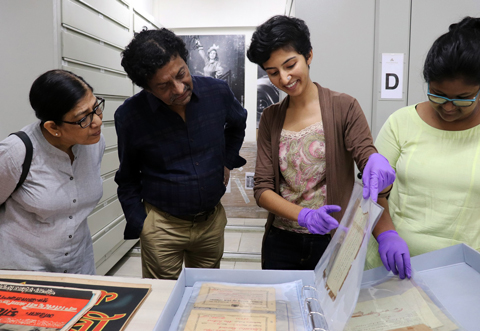
(Right) Filmmaker Gautam Ghose being taken through the FHF archives that hold some of Indian cinema's most extensive memorabilia.
Dungarpur and his team have restored several Indian treasures: the original camera negative of Guru Dutt’s Bharosa (which he retrieved from a kabaadiwala, a ragman deep within a Mumbai suburb); Mogacho Aunddo, a Portuguese-era Goan movie; a print of Gulzar’s iconic Maachis, which he found in a small shop in Madhya Pradesh; and just recently, a print of Farhan Akhtar’s contemporary classic, Dil Chahta Hai. “Till now, we were just preserving and archiving our cinematic heritage,” says Dungarpur. “But restoration is equally important. Film is a fragile medium and is prone to scratches and deterioration. Our restoration workshops (backed by entertainment company Viacom18 and Tata Trusts) help create a new generation of restorers.”
Archivists of memorabilia
FHF’s archive section is an oasis for cinema lovers. You can see a Mitchell camera; on a wall is a colorful poster of Fearless Nadia. In one corner, an employee
is sticking photographs in humidity-controlled albums. Someone is working on a reel of Dil Chahta Hai, while Govind Nihalani’s Drishti is being put into a dehumidifier.
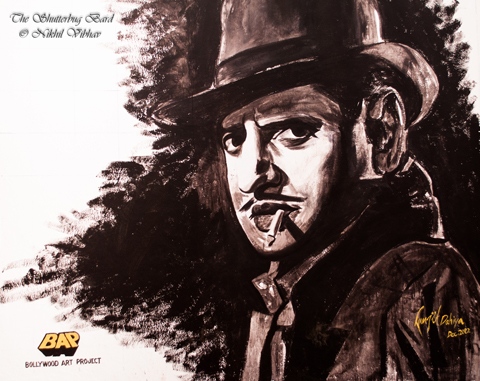
(Left) A hand painted poster of Pran, the “beloved” villain of Bollywood films, at the FHF.
Vaults hold an extensive archive of photographs, posters, lobby cards, song booklets, censor certificates, and more, donated by the families of actors, filmmakers, and even studios that have shut down. “We have several archival projects—actor, director, and writer A.R. Kardar, filmmakers Kidar Sharma, Saeed Akhar, Shyam Bengal and J.B.H Wadia, and actor Pran.” Dungarpur is also putting together a private archive of Amitabh Bachchan’s cinema, which will one day find its way to FHF. Among the memorabilia FHF holds are actor K. L. Saigal’s tabla and harmonium, archivist P. K. Nair’s spectacles, props from the sets of director Shyam Benegal films, and Fearless Nadia’s film posters and photographs.
As I walk across the FHF, I stumble upon shelves and drawers filled with publicity material, song booklets, and even personal archives of directors such as Vishal Bhardwaj and Saeed Mirza. I am transfixed by a section with tribal jewelry used in some of filmmaker Shyam Benegal’s movies and rare photographs from Satyajit Ray’s pathbreaking cinema.
Exploring India’s first national museum on cinema
The National Museum of Indian Cinema (NMIC), much like FHF, is home to well-researched and curated archives. It has a substantial collection of materials from the days when
actors were employees of film studios to now, when they are superstars. “It showcases the evolution of Indian cinema from its B&W days to today,” says Amrit Gangar, its consulting curator. “We looked at the different milestones in Indian cinema and documented them extensively.”
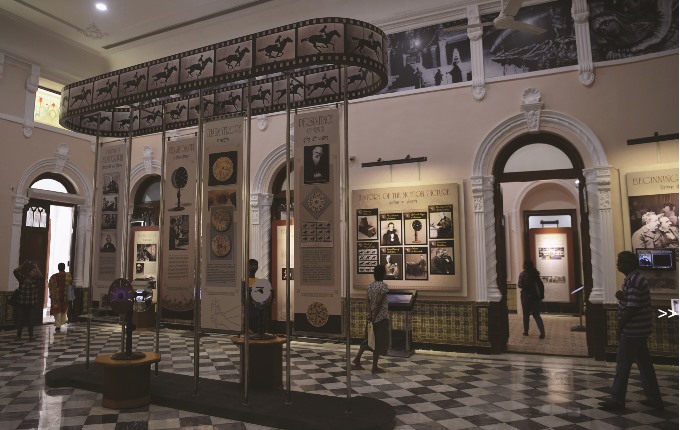
(Above) The National Museum of Indian Cinema (NMIC) is housed in a stately 19th-century Victorian structure built in the neo-Gothic style, located off Pedder Road in south Mumbai.
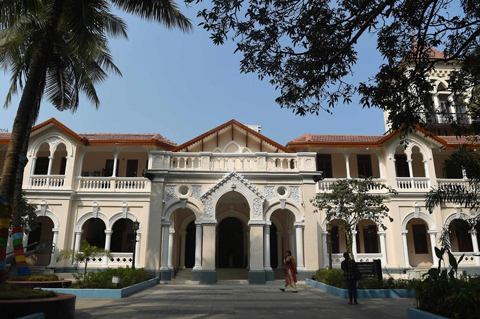
NMIC was built at a cost of $19.6 million and is housed in Gulshan Mahal, a stately 19th-century Victorian structure built in the neo-Gothic style, located off Pedder Road within south Mumbai. The museum’s picturesque setting, surrounded by old trees and with a view of the Arabian Sea close by, and its handmade tiles, vaulted ceilings, and wooden staircases make for a perfect setting.
In one section of the museum there is a fascinating account of the monumental day when Indians first had the opportunity to watch a movie; many were floored by what they saw on screen. On July 7, 1896, two French cinematographers, the Lumière brothers, showcased six films at the Watson Hotel in Mumbai (then Bombay). The showing was priced at Rs. 1, a princely sum in those days. India’s only English newspaper, The Times of India, referred to the event as “a miracle of the century.” The section also depicts the first movies made by Indians, both documentaries: The Flowers of Persia (1898) by photographer Hiralal Sen, and The Wrestlers by H. S. Bhatavdekar on Mumbai’s famous wrestling culture, which still exists.
Another section chronicles the rise of powerful film studios. From the late 1920s to the mid-1950s, Indian movie studios proved that social commitment, artistic creativity, and commercial viability could coexist. Studios such as Bombay Talkies, Mehboob Studios, Kamalistan, and RK Studio controlled the industry, employing actors and the crew on payrolls. Dev Anand began his career with Bombay Talkies at a princely salary of Rs. 85 per month. He owes his career to Ashok Kumar, whom he considered his idol, and who was an established “Bombay Talkies star.” Such fascinating history and nuggets come alive with memorabilia from the now defunct studios.
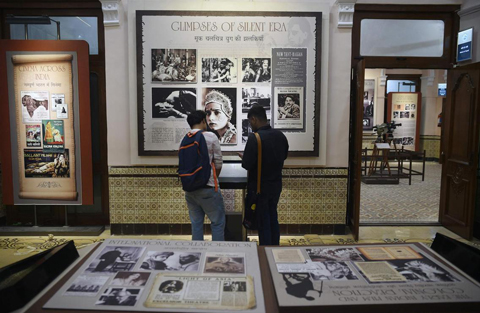
(Left) The Silent Era section at the NMIC.
Movie buffs can explore India’s landmark movies—Satyajit Ray’s Pather Panchali, for instance. An entire section is dedicated to Dadasaheb Phalke, who made India’s first full-length feature film, the silent Raja Harishchandra (1913). Exhibits include a screen on which plays a clip from the film; life-size effigies of the movie characters; and a ticket of the now defunct Alexander Cinema, where it was screened.
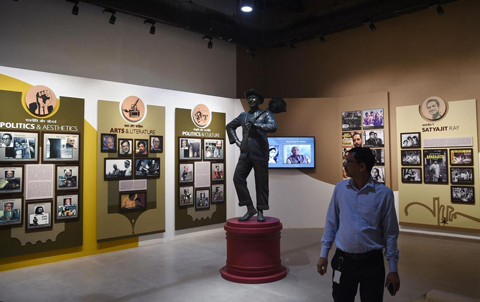
(Right) Raj Kapoor’s Awara statue at the NMIC.
“To impart a fun element to the proceedings, we provided points at which people can take selfies, such as a statue of Raj Kapoor in his Awara avatar,” adds Gangar. The museum has replicas of Mutoscope, a camera used by the Lumière brothers (who made the world’s first movie), and Praxinoscope—a spinning cylindrical animation device invented in France in the 1870s.
|
|
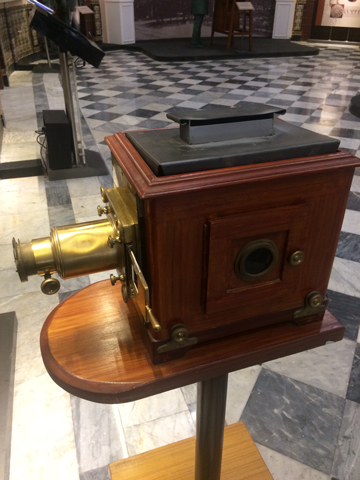
(Right) A curio from a bygone era of cinema: the Magic Lantern.
Among the exhibits are striking posters of Tapan Sinha’s Kabuliwala (1961), a collection of old cameras, and interactive visual effects tools. There are artefacts such as chitrapat, an unravelling scroll of pictures, and Magic Lantern, which shows a successive projection of glass-slide images. Display shelves hold one anna songbooks and lobby cards. This is where you will learn that there are seven iterations of Devdas: the original Hindi movie starred Dilip Kumar, Vyjayanthimala, and Suchitra Sen, but there have been multiple retellings in Hindi, Bengali, Assamese, Malayalam, and even Urdu.
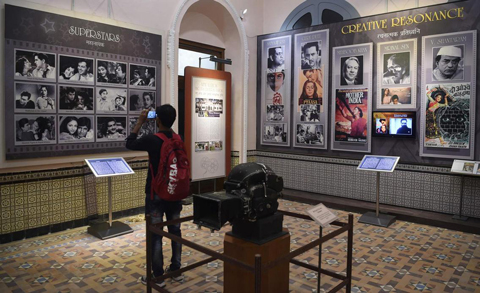
The “Superstars” section.
Four of Bollywood’s biggest superstars are represented: Dilip Kumar, Dev Anand, Amitabh Bachchan, and Shah Rukh Khan. Bachchan gets a large mention with a Sholay poster with its distinctive and influential typography. His knotted blue shirt from the movie, Deewar, one of his best acts as an ‘angry young man,’ finds a place in the costume section. Shah Rukh Khan’s mandolin from Dilwale Dulhania Le Jayenge is part of the music section.
Both FHF and NMIC have stupendous poster collections. Original posters are considered priceless. A head-turner at Shah Rukh Khan's residence, Mannat, is a tall, hand-painted poster of Mughal-e-Azam, depicting Anarkali and Prince Salim in a clinch, watched over by the glowering Emperor Akbar. Among Karan Johar’s prized possessions is an original poster of the Yash Johar-produced film Dostana, toplining Amitabh Bachchan, Zeenat Aman, and Shatrughan Sinha. “Someone sent it to me,” says Johar. “I would never, ever part with it. Nowadays, every filmmaker attempts to preserve posters of their movies for posterity. During my dad's time, perhaps there wasn’t sufficient awareness that every little bit of film history would become a rarity in the future. This is where museums such as NMIC step in—they help us preserve for posterity our cinema heritage.”
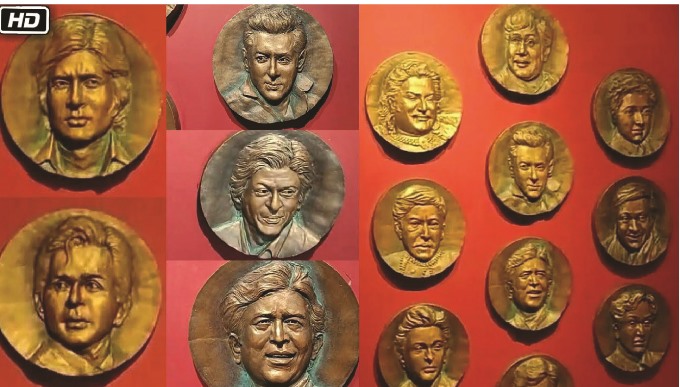
Murals of some of the luminaries of Indian cinema at the NMIC.
Getting the viewer involved
The museum comes alive in the Music and Visuals section where visitors can record their own voice over a soundtrack. While the section on film songs offers menu after menu of tracks to listen to, music director Ilayaraja’s songs play on a giant video wall of music. A documentary on how costumes were designed in Hollywood and Bollywood plays on loop in another section, next to three costumes in a glass
case. The Children’s Film Studio lets kids explore the magic of filmmaking and the world of Chroma studio in an immersive experience zone.
Music album covers and vinyl/LP records are there, and even a film printing machine. A documentary is shown about India’s first talkie, Alam Ara (1931). An animation station, a dubbing station, an editing station, and a green screen, where you can put yourself in a scene, complete the fabulous experience for cinema buffs like me.
From Gandhi to Charlie Chaplin—beyond the obvious
Very close to Gulshan Mahal, within the same precinct, is the New Museum building (also part of NMIC), an angular glass and chrome structure, in obvious reference to the contemporary architecture that has taken over Mumbai. It houses mobile exhibitions,
3D-compatible theatres, and four permanent exhibitions. Director Shyam Benegal, who is on NMIC’s advisory board, says the modern building has been built “by design, to distinguish between old cinema and new cinema. It is symbolic of the changing city of Mumbai, which is now a blend of the old city and the expanding new one.”
The permanent exhibitions include Gandhi and Cinema; Children’s Film Studio; Technology, Creativity, and Indian Cinema; and Cinema across India. The Gandhi and Cinema section introduces us to Mahatma Gandhi’s portrayal in movies, both Indian and international, particularly the overt and covert references to him in the works of Charlie Chaplin. The section holds a lifelike statue of the Mahatma, seemingly watching, on loop, Vijay Bhatt’s epic drama Ram Rajya (which, reportedly, he did watch in real life!). I watch a young boy spin a charkha while intently peering at a screen before him. As he spins, a timeline appears on the screen in front of him, with key dates and information.
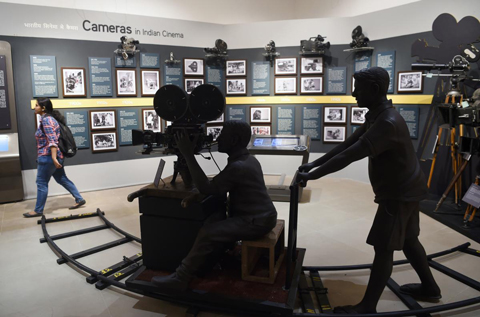
(Left) The “Cameras in Indian Cinema” section of the NMIC.
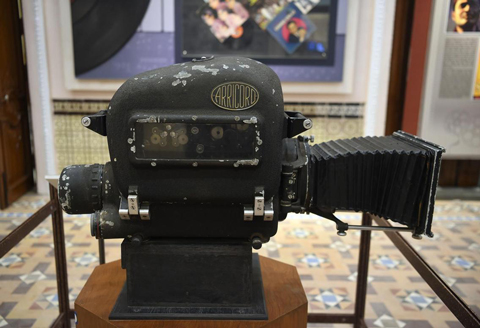
It is Level 3, however, that made me stop and stare. This is where exhaustive and impressive exhibits about technology and cameras are on display. To see a vast array, along with lenses, lights, and mixing apparatus with detailed stories of how ingenious filmmakers and technicians used them to create screen cinema, was inspiring. The exhibits revolve around Dadasaheb Phalke’s pioneering animation, filmmaker P. C. Barua’s flashback techniques, V. Shantaram’s tilted camera shots, and the special bounce light effect popularized by cinematographer Subrata Mitra in Satyajit Ray’s The Apu Trilogy.
(Left) A display of the Arricord motion picture camera.
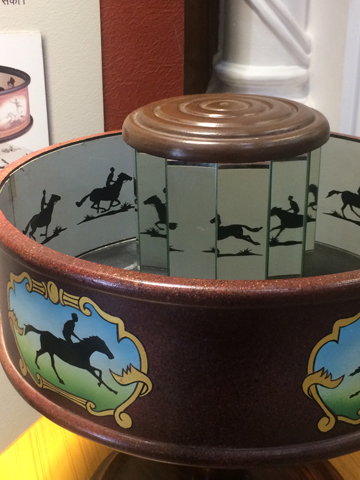
(Right) A curio from a bygone era of cinema: the Praxinoscope—a spinning cylindrical animation device invented in France in the 1870s.
In the age of digital photography and filmmaking, it is fascinating to read about the history of these monstrous cameras and instruments such as praxinoscopes, zoetropes, and mutoscopes, which were once considered indispensable to filmmaking. Cranes and dollies were widely used by the 1920s, and the steadicam became a standard machine by the 1960s. The camera became progressively more mobile as each decade passed, so that even standard Bollywood movies contained exterior shots.
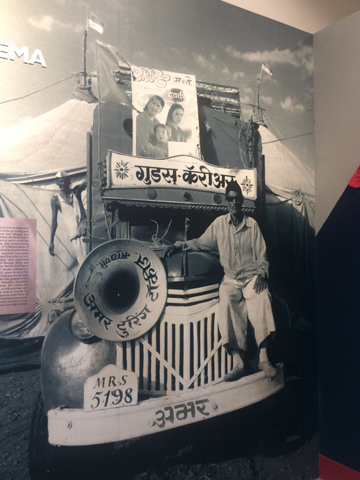
A section on India’s travelling exhibitors (photo, left) reveals that with their tents and rudimentary projectors, these adventurous souls popularized cinema across the length and breadth of India’s mofussil towns in the early 20th century. A replica of Watson’s Hotel in Mumbai takes us within the colonial-style hotel building where the first movie was screened. This is the only place where you can see such a detailed replica: the original building has long been torn down, to be replaced by a new glass structure.
Benegal admits that not enough space has been afforded to cinemas beyond Hindi cinema. “The tragedy is that it is difficult to find original memorabilia. People treat the pathbreaking work of our great directors with a lot of disdain. Many film families continue to hold on to the memorabilia and cinematic heirlooms instead of donating them to a museum, which is where they rightly belong.” According to Dungarpur, the museum has “too many dry details. It isn’t interactive and entertaining enough; it isn’t experiential.”
But in a country where there is so little available on the heritage of Indian cinema in the public domain, institutions such as FHF and the NMIC offer tantalizing glimpses into its past even as they preserve the unparalleled history.
Deepali Nandwani is a Mumbai-based freelance journalist, a columnist on luxury with CNBC-TV18, and an aficionado of everything heritage.
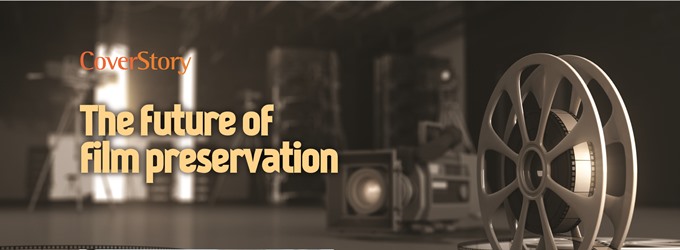
Shivendra Singh Dungarpur insists that film preservation isn’t just for old movies. Even as archivists and museums continue to unearth early material, in the digital age preservation has moved beyond scouring basements and attics for deteriorating prints. New concerns, complications, and strategies to deal with them have come to the fore. “Every solution you come up with uncovers a different set of problems. There was a time when nitrate-based film was considered superior. But over time, it was found to be chemically unstable and flammable. When the industry sorted that issue out, came in acetate film, which led to color fading. The industry found a solution with a low-fade stock, but we found that acetate film also deteriorated. Now, with digital, people assume you’ve solved all your problems. But, there are a new set of challenges. Software goes obsolete in just a few years and it means unless you upgrade, you are not going to be able to save the film which was shot on an old camera, using software which is no longer in currency,” he adds.
In the U.S., cinema shot on digital cameras are being saved on film. “There's an increasing realization that film is still the preservation medium,” says Dungarpur. “It's still more stable and reliable than the digital. But that's not a practice followed widely. The rule is to store it in the current digital format and then migrate it to the newest format every few years.” As software, as well as hardware, constantly change and upgrade, the art of archiving, preservation, and restoration will have to keep up with the massive tech changes.
|
The future of cinema archiving and museums |
|
Gian Luca Farinelli says that the world has several film archives, but specialized laboratories are few and far between. “It is important to preserve and restore old cinema on both film and digital equipment, which is what FHF will need to start doing. More importantly, film restoration should not be confined to specialized laboratories. They should be exhibited to garner more support, both financial and otherwise.” FHF, which has an extensive archive in their New Bombay facility (besides the one in south Mumbai) is working on bringing the entire collection together in a bigger facility with an auditorium to exhibit restored films, along with curated thematic shows drawn from the rich cache of memorabilia that are part of their archives. NMIC already has a 250-seat auditorium, where they intend to screen old movies and documentaries. Gangar says, “If you want people to keeping coming back, you need to ensure that there are screenings to get them back. Also, this would help to showcase the complex legacy of Indian cinema’s over-century-long journey.” |
Enjoyed reading Khabar magazine? Subscribe to Khabar and get a full digital copy of this Indian-American community magazine.
blog comments powered by Disqus




